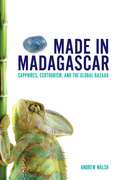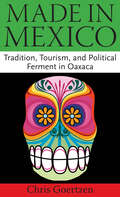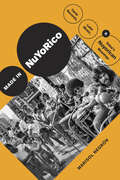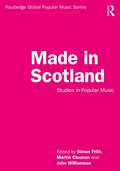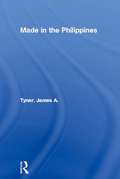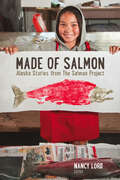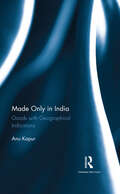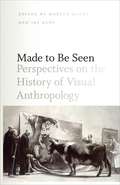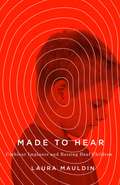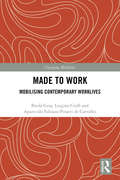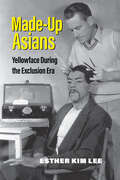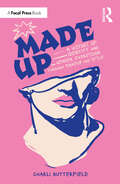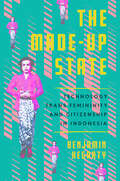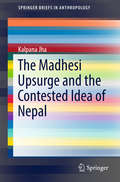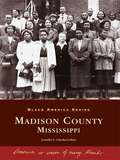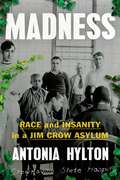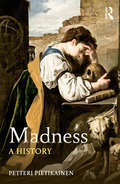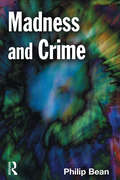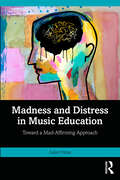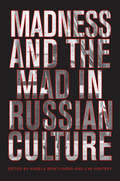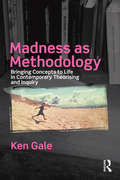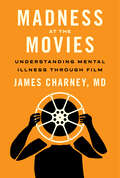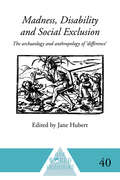- Table View
- List View
Made in Japan and Other Japanese Business Novels
by Tamae K. PrindleThe term "business novel" is a translation of the Japanese word kezai shosetsu, which may be translated literally as * 'economy novel.'' Critic Makoto Sataka first used the word "business" in place of "economy" in his monograph How to Read Business Novels (1980).l Business novels are "popular novels" (taishu bungaku) widely read by Japanese businessmen, their wives, students, and other professionals.. Business novels were recognized as a * 'field'' or a literary sub-genre in the late 1950s. It was Saburo Shiroyama's Export (Yushutsu) (1957), if not his Kinjo the Corporate Bouncer (Sokaiya Kinjo) (1959), which marshalled their enormous popularity. The seven short works in this collection represent prototypes of the business novel. Their distinctive features are that business activities motivate plot developments, although psycho-socio-cultural elements are tightly interwoven.
Made in Madagascar: Sapphires, Ecotourism, And The Global Bazaar (Teaching Culture: Utp Ethnographies For The Classroom Ser.)
by Andrew WalshSince the 1990s, the Ankarana region of northern Madagascar has developed a reputation among globe-trotting gemstone traders and tourists as a source of some of the world's most precious natural wonders. Although some might see Ankarana's sapphire and ecotourist trades as being at odds with each other, many local people understand these trades to be fundamentally connected, most obviously in how both serve foreign demand for what Madagascar has to offer the world. Walsh explores the tensions and speculations that have come with the parallel emergence of these two trades with sensitivity and a critical eye, allowing for insights into globalization, inequality, and the appeal of the "natural." For more information, and to read a hyperlinked version of the first chapter online, visit www.madeinmadagascar.org.
Made in Mexico: Tradition, Tourism, and Political Fermant in Oaxaca
by Chris GoertzenMade in Mexico examines the aesthetic, political, and sociopolitical aspects of tourism in southern Mexico, particularly in the state of Oaxaca. Tourists seeking "authenticity" buy crafts and festival tickets and spend even more on travel expenses. What does a craft object or a festival moment need to look like or sound like to please both tradition bearers and tourists in terms of aesthetics? Under what conditions are transactions between these parties psychologically healthy and sustainable? What political factors can interfere with the success of this negotiation, and what happens when the process breaks down? With Subcommandante Marcos and the Zapatistas still operating in neighboring Chiapas and unrest on the rise in Oaxaca itself, these are not merely theoretical problems. Chris Goertzen analyzes the nature and meaning of a single craft object, a woven pillowcase from Chiapas, thus previewing what the book will accomplish in greater depth in Oaxaca. He introduces the book's guiding concepts, especially concerning the types of aesthetic intensification that have replaced fading cultural contexts, and the tragic partnership between ethnic distinctiveness and oppressive politics. He then brings these concepts to bear on crafts in Oaxaca and on Oaxaca's Guelaguetza, the anchor for tourism in the state and a festival with an increasingly contested meaning.
Made in NuYoRico: Fania Records, Latin Music, and Salsa’s Nuyorican Meanings (Refiguring American Music)
by Marisol NegrónIn Made in NuYoRico, Marisol Negrón tells the cultural history of salsa, tracing the music’s Nuyorican meanings over a fifty-year period that begins with the establishment of Fania Records in 1964 and how it capitalized on salsa’s Nuyorican imaginary to cultivate a global audience. Drawing on interviews with fans, legendary musicians, and music industry figures as well as analyses of songs, albums, films, and archival documents, Negrón shows how Nuyorican cultural and social histories became embedded in and impacted salsa music's flows during its foundational period in the mid-1960s and its boom in the 1970s. Salsa’s Nuyorican aesthetics challenged mainstream notions of Americanness and Puerto Ricanness and produced an alternative public sphere through which New York’s poor and working-class Puerto Ricans could contest racialization and colonial power. By outlining salsa’s complicated musical, cultural, commercial, racial, gendered, legal, and political entanglements, Negrón demonstrates its centrality to Nuyorican identity and subjectivity.
Made in Scotland: Studies in Popular Music (Routledge Global Popular Music Series)
by Simon Frith Martin Cloonan John WilliamsonMade in Scotland: Studies in Popular Music serves as a comprehensive and thorough introduction to the history, politics, culture, and musicology of twentieth- and twenty-first-century popular music in Scotland. The volume consists of essays by local experts and leading scholars in Scottish music and culture, and covers the major figures, styles, and social contexts of popular music in Scotland. Each essay provides adequate context so readers understand why the figure or genre under discussion is of lasting significance. The book includes a general introduction to Scottish popular music, followed by essays organized into three thematic sections: Histories, Politics and Policies, and Futures and Imaginings. Examining music as cultural expression in a country that is both a nation and a region within a larger state, this volume uses popular music to analyse Scottishness, independence, and diversity and offers new insights into the complexity of cultural identity, the power of historical imagination, and the effects of power structures in music. It is a vital read for scholars and students interested in how popular music interacts with and shapes such issues both within and beyond the borders of Scotland.
Made in the Philippines (Routledge Pacific Rim Geographies #Vol. 5)
by James A. TynerThe Philippines is the world's largest exporter of temporary contract labor with a huge 800,000 workers a year being deployed on either six month or two year contracts. This labor migration is highly regulated by the government, private, and non-governmental/non-private organizations. Tyner argues that migrants are socially constructed, or 'made' by these parties and that migrants in turn become political resources. Employing a post-structural feminist perspective Tyner questions the very ontology of migration.
Made of Salmon: Alaska Stories from the Salmon Project
by Nancy LordAll over the world, salmon populations are in trouble, as overfishing and habitat loss have combined to put the once-great Atlantic and Pacific Northwest runs at serious risk. Alaska, however, stands out as a rare success story: its salmon populations remain strong and healthy, the result of years of careful management and conservation programs that are rooted in a shared understanding of the importance of the fish to the life, culture, and history of the state. Made of Salmon brings together more than fifty diverse Alaska voices to celebrate the salmon and its place in Alaska life. A mix of words and images, the book interweaves longer works by some of Alaska’s finest writers with shorter, more anecdotal accounts and stunning photographs of Alaskans fishing for, catching, preserving, and eating salmon throughout the state. A love letter to a fish that has been central to Alaska life for centuries, Made of Salmon is a reminder of the stakes of this great, ongoing conservation battle.
Made Only in India: Goods with Geographical Indications
by Anu KapurWhat makes Darjeeling tea, Pashmina shawl, Monsooned Malabar Arabica coffee and Chanderi saree special? Why is it that some goods derive their uniqueness through their inherent linkage to a place? In a pioneering study, this book explores this intriguing question in the Indian context across 199 registered goods with geographical indications, linked with their place of origin. It argues that the origin of these goods is attributed to a distinctive ecology that brews in a particular place. The attributes of their origin further endorse their unique geographical indications through legal channels. Drawing from a variety of disciplines including geography, history, sociology, handicrafts, paintings, and textiles, the author also examines the Geographical Indications Act of 1999, and shows how it has created a scope to identify, register and protect those goods, be they natural, agricultural, or manufactured. The work presents a new perspective on the indigenous diversities and offers an original understanding of the geography and history of India. Lucid and accessible, with several illustrative maps, this book will be useful to scholars and researchers in the social sciences, environmental studies, development studies, law, trade and history.
Made to Be Seen: Perspectives on the History of Visual Anthropology
by Marcus Banks and Jay RubyMade to be Seen brings together leading scholars of visual anthropology to examine the historical development of this multifaceted and growing field. Expanding the definition of visual anthropology beyond more limited notions, the contributors to Made to be Seen reflect on the role of the visual in all areas of life. Different essays critically examine a range of topics: art, dress and body adornment, photography, the built environment, digital forms of visual anthropology, indigenous media, the body as a cultural phenomenon, the relationship between experimental and ethnographic film, and more. The first attempt to present a comprehensive overview of the many aspects of an anthropological approach to the study of visual and pictorial culture, Made to be Seen will be the standard reference on the subject for years to come. Students and scholars in anthropology, sociology, visual studies, and cultural studies will greatly benefit from this pioneering look at the way the visual is inextricably threaded through most, if not all, areas of human activity.
Made to Hear: Cochlear Implants and Raising Deaf Children (A Quadrant Book)
by Laura MauldinA mother whose child has had a cochlear implant tells Laura Mauldin why enrollment in the sign language program at her daughter&’s school is plummeting: &“The majority of parents want their kids to talk.&” Some parents, however, feel very differently, because &“curing&” deafness with cochlear implants is uncertain, difficult, and freighted with judgment about what is normal, acceptable, and right. Made to Hear sensitively and thoroughly considers the structure and culture of the systems we have built to make deaf children hear.Based on accounts of and interviews with families who adopt the cochlear implant for their deaf children, this book describes the experiences of mothers as they navigate the health care system, their interactions with the professionals who work with them, and the influence of neuroscience on the process. Though Mauldin explains the politics surrounding the issue, her focus is not on the controversy of whether to have a cochlear implant but on the long-term, multiyear undertaking of implantation. Her study provides a nuanced view of a social context in which science, technology, and medicine are trusted to vanquish disability—and in which mothers are expected to use these tools. Made to Hear reveals that implantation has the central goal of controlling the development of the deaf child&’s brain by boosting synapses for spoken language and inhibiting those for sign language, placing the politics of neuroscience front and center.Examining the consequences of cochlear implant technology for professionals and parents of deaf children, Made to Hear shows how certain neuroscientific claims about neuroplasticity, deafness, and language are deployed to encourage compliance with medical technology.
Made To Work: Mobilising Contemporary Worklives (Changing Mobilities)
by Breda Gray Luigina Ciolfi Aparecido Fabiano de CarvalhoMade to Work analyses the conditions of mobile knowledge work (MKW) in contemporary worklives, contrasting and drawing parallels among three highly significant sectors of the Knowledge Economy: academia, information communication technology (ICT) management, and digital creative work. It introduces the concept of ‘corollary work’ to characterise the elusive work underpinning the configuration of workers, informational, technological, relational and infrastructural resources in (re)producing liveable worklives. It ultimately illuminates the myriad strands of corollary work that enable MKW to take place and contributes to emergent debates on how exploitation, at least in the domain of MKW, can be named, resisted and creatively subverted. In so doing, it opens up a conversation about the complex ways in which contemporary worklives are ‘made to work’, and about potential interventions to bring about more just worklife conditions in the future.
Made-Up Asians: Yellowface During the Exclusion Era
by Esther Kim LeeMade-Up Asians traces the history of yellowface, the theatrical convention of non-Asian actors putting on makeup and costume to look East Asian. Using specific case studies from European and U.S. theater, race science, and early film, Esther Kim Lee traces the development of yellowface in the U.S. context during the Exclusion Era (1862–1940), when Asians faced legal and cultural exclusion from immigration and citizenship. These caricatured, distorted, and misrepresented versions of Asians took the place of excluded Asians on theatrical stages and cinema screens. The book examines a wide-ranging set of primary sources, including makeup guidebooks, play catalogs, advertisements, biographies, and backstage anecdotes, providing new ways of understanding and categorizing yellowface as theatrical practice and historical subject. Made-Up Asians also shows how lingering effects of Asian exclusionary laws can still be seen in yellowface performances, casting practices, and anti-Asian violence into the 21st century.
Made Up: A History of Identity and Gender Expression Through Makeup and Style
by Charli ButterfieldThis book explores historical and modern uses of makeup for self-expression, with a focus on gender.The book begins by exploring the historical influences in the origins and development of makeup across genders, providing a whistle-stop tour of gendered adornment through time. The chapters that follow explore more specific topics that provide context for a range of influences on self-expression: Sex, gender and identity, including introductory gender theory and terminology relevant to the topic. Restrictions and resistance faced by the queer community regarding expression, with a historical look at pioneers of the movement. Gendered cosmetic advertisements through time. Subcultures and coded expression. Beauty and identity in the digital age. The impact of global ideals on the cosmetics market, with a focus on South Korea, exploring historical and modern influences and trends. The book can be explored in a sequential or non-sequential order, as each chapter provides a standalone approach to a topic and concludes with questions to encourage further contemplation and research.This book is written for anyone interested in the history of makeup as a vehicle for self-expression, and how gender comes into play; students and teachers of Theatrical makeup and Fashion courses, makeup artists, makeup enthusiasts, and those curious to discover what Ancient Egyptians and emos may have in common (spoiler: it’s not snakebites).
The Made-Up State: Technology, Trans Femininity, and Citizenship in Indonesia
by Benjamin HegartyIn The Made-Up State, Benjamin Hegarty contends that warias, who compose one of Indonesia's trans feminine populations, have cultivated a distinctive way of captivating the affective, material, and spatial experiences of belonging to a modern public sphere. Combining historical and ethnographic research, Hegarty traces the participation of warias in visual and bodily technologies, ranging from psychiatry and medical transsexuality to photography and feminine beauty. The concept of development deployed by the modern Indonesian state relies on naturalizing the binary of "male" and "female." As historical brokers between gender as a technological system of classifying human difference and state citizenship, warias shaped the contours of modern selfhood even while being positioned as nonconforming within it. The Made-Up State illuminates warias as part of the social and technological format of state rule, which has given rise to new possibilities for seeing and being seen as a citizen in postcolonial Indonesia.
The Madhesi Upsurge and the Contested Idea of Nepal
by Kalpana JhaThis book is set against the burning issue of ethnic uprisings in the Madhes region of Nepal and analyses debates on the idea of contemporary Nepal. The limited view of Nepal as a primarily hill nation with Nepali-speaking people ignores the vast ethnic and linguistic diversity of the country. It has particularly rendered stateless the Madhesi community which inhabits the plains bordering India and shares closer cultural affinity and marital ties across the border. Increasing demands for ethnic and territorial autonomy by the Madhesis suggest the need for redefining the idea of Nepal and establishing Madhesi identity as Nepali identity while at the same time addressing the deeply contested idea of regional versus social identity in the region. This book uses narratives from the Madhesi community including from prominent Madhesi analysts and activists, to define their identity as well as their aspirations in a democratic Nepal. It also provides a perspective on the internal dynamics of caste and language of this region and their possible impact on consolidating ethnic identities in Nepal.
Madison County, Mississippi (Black America Series)
by Jennifer E. Cheeks-CollinsKnown as the "Land Between Two Rivers," Madison County is situated between the Pearl River to the east and the Big Black River to the west. It was created in 1828, and African slaves were among its earliest settlers. As the county grew, the African-American society began to create roots in this region, and their legacy continues to this day. Black America: Madison County explores a community marked by struggle, poverty, and segregation, a community that finally gained its voice during the Civil Rights Movement of the 1960s. This volume celebrates the lives of Madison County's black residents-past and present-and tells their story through vintage photographs.
Madness: Race and Insanity in a Jim Crow Asylum
by Antonia HyltonIn the tradition of The Immortal Life of Henrietta Lacks, this New York Times bestseller is a page-turning account of one of the nation&’s last segregated asylums..."a book that left me breathless" (Clint Smith). For centuries, Black patients have been absent from our history books. Madness transports readers through the ninety-three-year history of Crownsville Hospital, one of the last segregated asylums with surviving records and a campus that still stands to this day in Anne Arundel County, Maryland. Antonia Hylton blends the intimate tales of patients and employees whose lives were shaped by Crownsville with a decade-worth of investigative research and archival documents. Madness chronicles the stories of Black families whose mental health suffered as they tried, and sometimes failed, to find safety and dignity. Hylton also grapples with her own family&’s experiences with mental illness, and the secrecy and shame that it reproduced for generations. As Crownsville Hospital grew from an antebellum-style work camp to a tiny city sitting on 1,500 acres, the institution became a microcosm of America&’s evolving battles over slavery, racial integration, and civil rights. Hylton traces the legacy of slavery to the treatment of Black people&’s bodies and minds in our current mental healthcare system. It is a captivating and heartbreaking meditation on how America decides who is sick or criminal, and who is worthy of our care or irredeemable.
Madness: A History
by Petteri PietikäinenMadness: A History is a thorough and accessible account of madness from antiquity to modern times, offering a large-scale yet nuanced picture of mental illness and its varieties in western civilization. The book opens by considering perceptions and experiences of madness starting in Biblical times, Ancient history and Hippocratic medicine to the Age of Enlightenment, before moving on to developments from the late 18th century to the late 20th century and the Cold War era. Petteri Pietikäinen looks at issues such as 18th century asylums, the rise of psychiatry, the history of diagnoses, the experiences of mental health patients, the emergence of neuroses, the impact of eugenics, the development of different treatments, and the late 20th century emergence of anti-psychiatry and the modern malaise of the worried well. The book examines the history of madness at the different levels of micro-, meso- and macro: the social and cultural forces shaping the medical and lay perspectives on madness, the invention and development of diagnoses as well as the theories and treatment methods by physicians, and the patient experiences inside and outside of the mental institution. Drawing extensively from primary records written by psychiatrists and accounts by mental health patients themselves, it also gives readers a thorough grounding in the secondary literature addressing the history of madness. An essential read for all students of the history of mental illness, medicine and society more broadly.
Madness and Crime: Critical Concepts In Criminology
by Philip BeanThis book provides an authoritative and highly readable review of the relationship between madness and crime by one of the leading authorities in the field. The book is divided into four parts, each essay focusing on selected features of madness which have relevance to contemporary society. Part 1 is about madness itself, exploring three main models − cognitive, statistical, and emotional. Part 2 is a short discussion on madness, genius and creativity. Part 3 is about the much neglected area of compulsion, an issue that has largely disappeared from public debate. The mad may have moved from victim to violator, yet fundamental questions remain − in particular how to justify compulsory detention, and who should undertake the process? The answers to these questions have sociological, ethical and jurisprudential elements, and cannot just re resolved by reference to medical authorities. Part 4 is about the links between madness and crime − focusing less on the question and nature of criminal responsibility and the various defences that go with this, more on the links between madness and crime and which particular crimes are linked with which types of disorder.
Madness and Distress in Music Education: Toward a Mad-Affirming Approach
by Juliet HessMadness and Distress in Music Education offers an in-depth exploration of mental health and emotional distress in the context of music education, offering new ways of thinking about these experiences and constructing ways to support distress through affirming pedagogy, practices, and policies in music education. Centering the lived experiences of 15 people in a range of roles across music education who self-identify an issue with their mental health, the volume addresses impacts on both students and educators. The author draws on Mad Studies and disability studies to present new paradigms for thinking about Madness and distress in the music context. An essential resource for music educators, music education researchers, and preservice students seeking to understand the complexities of mental health in the music classroom, this book considers how people conceptualize their mental health, how distress impacts participation in music education, how music education may support or exacerbate distress, and what supports for distress can be implemented in music education.
Madness and the Mad in Russian Culture
by Ilya Vinitsky Angela BrintlingerThe problem of madness has preoccupied Russian thinkers since the beginning of Russia's troubled history and has been dealt with repeatedly in literature, art, film, and opera, as well as medical, political, and philosophical essays. Madness has been treated not only as a medical or psychological matter, but also as a metaphysical one, encompassing problems of suffering, imagination, history, sex, social and world order, evil, retribution, death, and the afterlife.Madness and the Mad in Russian Culture represents a joint effort by American, British, and Russian scholars - historians, literary scholars, sociologists, cultural theorists, and philosophers - to understand the rich history of madness in the political, literary, and cultural spheres of Russia. Editors Angela Brintlinger and Ilya Vinitsky have brought together essays that cover over 250 years and address a wide variety of ideas related to madness - from the involvement of state and social structures in questions of mental health, to the attitudes of major Russian authors and cultural figures towards insanity and how those attitudes both shape and are shaped by the history, culture, and politics of Russia.
Madness as Methodology: Bringing Concepts to Life in Contemporary Theorising and Inquiry
by Ken GaleMadness as Methodology begins with the following quotation from Deleuze and Guattari, ‘Madness need not be all breakdown. It may also be breakthrough.’ This quotation firmly expresses the book’s intention to provide readers with radical and innovative approaches to methodology and research in the arts, humanities and education practices. It conceptualises madness, not as a condition of an individual or particular being, but rather as a process that does things differently in terms of creativity and world making. Through a posthuman theorising as practice, the book emphasises forms of becoming and differentiation that sees all bodies, human and nonhuman, as acting in constant, fluid, relational play. The book offers a means of breaking through and challenging the constraints and limitations of Positivist approaches to established research practice. Therefore, experimentation, concept making as event and a going off the rails are offered as necessary means of inquiry into worlds that are considered to be always not yet known. Rather than using a linear chapter structure, the book is constructed around Deleuze and Guattari’s use of an assemblage of plateaus, providing the reader with a freedom of movement via multiple entry and exit points to the text. These plateaus are processually interconnected providing a focal emphasis upon topics apposite to this madness as methodology. Therefore, as well as offering a challenge to the constraining rigours of conventional research practices, these plateaus engage with topics to do with posthuman thinking, relationality, affect theory, collaboration, subjectivity, friendship, performance and the use of writing as a method of inquiry.
Madness at the Movies: Understanding Mental Illness through Film
by James CharneyA unique exploration of how mental illness is portrayed in classic and contemporary films.The study of classic and contemporary films can provide a powerful avenue to understand the experience of mental illness. In Madness at the Movies, James Charney, MD, a practicing psychiatrist and long-time cinephile, examines films that delve deeply into characters' inner worlds, and he analyzes moments that help define their particular mental illness. Based on the highly popular course that Charney taught at Yale University and the American University of Rome, Madness at the Movies introduces readers to films that may be new to them and encourages them to view these films in an entirely new way. Through films such as Psycho, Taxi Driver, Through a Glass Darkly, Night of the Hunter, A Woman Under the Influence, Ordinary People, and As Good As It Gets, Charney covers an array of disorders, including psychosis, paranoia, psychopathy, depression, bipolar disorder, obsessive-compulsive disorder, and anxiety. He examines how these films work to convey the essence of each illness. He also looks at how each film reflects the understanding of mental illness at the time it was released as well as the culture that shaped that understanding.Charney explains how to observe the behaviors displayed by characters in the films, paying close attention to signs of mental illness. He demonstrates that learning to read a film can be as absorbing as watching one. By viewing these films through the lens of mental health, readers can hone their observational skills and learn to assess the accuracy of depictions of mental illness in popular media.
Madness, Bureaucracy and Gender in Mumbai, India: Narratives from a Psychiatric Hospital
by Annika StraussRegional mental hospitals in India are perceived as colonial artefacts in need of reformation. In the last two decades, there has been discussion around the maltreatment of patients, corruption and poor quality of mental health treatment in these institutions. This ethnography scrutinizes the management of madness in one of these asylum-like institutions in the context of national change and the global mental health movement. The author explores the assembling and impact of psychiatric, bureaucratic, gendered and queer narratives in and around the hospital. Finally, the author attempts to reconcile social anthropology and psychiatry by scrutinising their divergent approaches towards ‘mad narratives’.
Madness, Disability and Social Exclusion: The Archaeology and Anthropology of 'Difference' (One World Archaeology #Vol. 40)
by Jane HubertA unique work that brings together a number of specialist disciplines, such as archaeology, anthropology, disability studies and psychiatry to create a new perspective on social and physical exclusion from society. A range of evidence throws light on such things as the causes and consequences of social exclusion stigma, marginality and dangerousness.It is an important text that breaks down traditional academic disciplinary boundaries and brings a much needed comparative approach to the subject.

